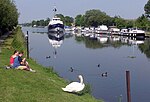WWT Slimbridge

WWT Slimbridge is a wetland wildlife reserve near Slimbridge in Gloucestershire, England. It is midway between Bristol and Gloucester on the eastern side of the estuary of the River Severn. The reserve, set up by the artist and naturalist Sir Peter Scott, opened in November 1946. Scott subsequently founded the Wildfowl & Wetlands Trust, which has since opened nine other reserves around the country. Slimbridge comprises some 800 hectares (2,000 acres) of pasture, reed bed, lagoon and salt marsh. Many water birds live there all year round, and others are migrants on their ways to and from their summer breeding grounds. Other birds overwinter, including large numbers of white-fronted geese and increasing numbers of Bewick's swans. Besides having the world's largest collection of captive wildfowl, Slimbridge takes part in research and is involved in projects and internationally run captive breeding programmes. It was there that Peter Scott developed a method of recognising individual birds through their characteristics, after realising that the coloured patterns on the beaks of Bewick's swans were unique. The public can visit the reserve throughout the year. Besides examining the collections, they can view birds from hides and observatories and take part in educational activities.
Excerpt from the Wikipedia article WWT Slimbridge (License: CC BY-SA 3.0, Authors, Images).WWT Slimbridge
Summer Walkway,
Geographical coordinates (GPS) Address Nearby Places Show on map
Geographical coordinates (GPS)
| Latitude | Longitude |
|---|---|
| N 51.741471 ° | E -2.405979 ° |
Address
New Decoy Pool
Summer Walkway
GL2 7BT , Slimbridge
England, United Kingdom
Open on Google Maps







